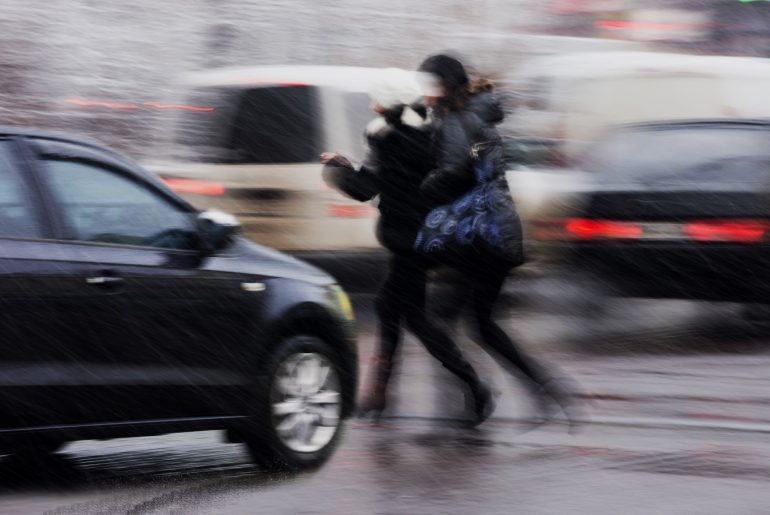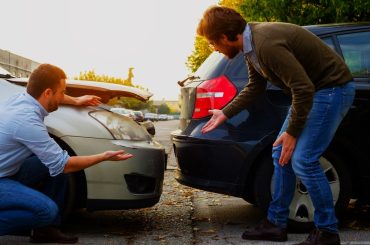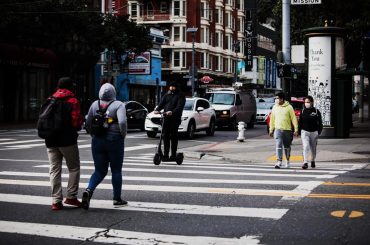Every day, countless Californians walk and drive along the bustling streets of our cities and towns. In this constant dance of pedestrians and vehicles, crosswalks are critical intersections where their paths often converge. Unfortunately, this convergence can sometimes lead to serious accidents. A particularly concerning scenario is when a pedestrian is hit by a car in a crosswalk accidents. This article aims to shed light on such incidents, focusing on the crucial question: “Who is liable when a pedestrian is hit by a car in the crosswalk in California?“
Understanding liability in these situations is not just a matter of legal curiosity; it’s essential knowledge that affects everyone. For pedestrians, it’s about knowing your rights and the protections afforded to you under the law. For drivers, it’s about understanding the responsibilities you bear every time you get behind the wheel. This knowledge isn’t just academic—it can impact decisions made every day, from how a pedestrian navigates a crossing to how a driver approaches a crosswalk.
Audience Acknowledgement
We recognize that our readers come from diverse backgrounds, with varying degrees of familiarity with legal concepts. Some of you may have never needed to consider the legal implications of a traffic incident, while others might have some understanding of legal matters. Regardless of where you fall on this spectrum, this article is crafted for you. We strive to present the information in a manner that is easily understandable to those with no legal background, yet sufficiently detailed to be of value to those who have some familiarity with legal principles.
Our goal is to bridge the gap between complex legal jargon and the practical information you need. Whether you are a pedestrian, a driver, or simply a concerned citizen, this article aims to equip you with the knowledge to navigate the legal landscape of pedestrian-vehicle incidents in California. Let’s embark on this journey of understanding together.
If you get hit by a car while in a crosswalk,
Determining who is responsible, or “liable,” for the accident typically depends on several factors, including the specifics of the situation and the laws in the jurisdiction where the accident occurred. In California, as in many places, the following considerations are important in determining liability:
- Pedestrian Rights in Crosswalks: Generally, pedestrians have the right of way in crosswalks in California. If you are crossing the street within a marked or unmarked crosswalk and you comply with traffic signals, the driver of the car is usually expected to yield to you.
- Driver Responsibilities: Drivers are expected to exercise caution and reduce speed near crosswalks, be vigilant for pedestrians, and yield the right of way to pedestrians in crosswalks. If a driver fails to do so and hits a pedestrian, they could be found negligent and therefore liable for the accident.
- Negligence and Fault: Determining who is at fault often revolves around the concept of negligence. If the driver was speeding, distracted, or otherwise not adhering to traffic laws, they could be found negligent. However, if the pedestrian was jaywalking, crossing against a traffic signal, or walking while distracted (e.g., using a phone), they might also be considered partly at fault.
- Comparative Negligence: California follows a “comparative negligence” rule. This means that if both the pedestrian and the driver share some degree of fault, the liability for damages may be divided between them according to their respective shares of fault. For example, if a pedestrian is found to be 20% at fault for an accident and the driver 80% at fault, any damages awarded to the pedestrian would be reduced by 20%.
- Evidence and Investigation: The specific circumstances of the accident, such as witness statements, traffic camera footage, and police reports, will play a crucial role in determining liability.
- Legal and Insurance Proceedings: Ultimately, liability is often determined through insurance claims processes or legal proceedings if a lawsuit is filed.
Pedestrian Rights and Driver Responsibilities
Navigating the roads of California, whether as a pedestrian or a driver, comes with a set of rules and responsibilities designed to ensure safety for all. Understanding these is crucial, especially in scenarios involving crosswalks, where pedestrian and vehicular paths intersect.
What is Pedestrian Rights in California?
In California, pedestrian rights are designed to protect individuals on foot, particularly in areas of potential interaction with vehicles, like crosswalks.
- Right of Way in Crosswalks: Pedestrians in California have the right of way in marked or unmarked crosswalks at intersections. This means that vehicles must yield to pedestrians crossing the roadway within any marked or unmarked crosswalk.
- Signalized Crosswalks: At intersections with traffic control signals, pedestrians must obey the pedestrian signals and have the right of way when the signal indicates it’s safe to cross.
- Sidewalks and Pedestrian Paths: Pedestrians have the exclusive right to use sidewalks. When sidewalks are not available, pedestrians should walk on the left side of the road, facing traffic.
- Visibility and Vigilance: While pedestrians have these rights, they also have the duty to be visible (e.g., wearing reflective clothing at night) and to exercise care for their safety (e.g., not suddenly leaving a curb or other safe areas to walk or run into the path of a vehicle that is so close it is impossible for the driver to yield).
Driver Responsibilities Towards Pedestrians
Drivers in California are expected to exercise care and caution, particularly when it comes to interactions with pedestrians.
- Yielding to Pedestrians: Drivers must yield the right-of-way to pedestrians crossing the roadway within any marked or unmarked crosswalk at an intersection. This is an absolute requirement, regardless of the situation.
- Reduced Speeds in Pedestrian Areas: Drivers are expected to reduce their speed in areas of high pedestrian traffic, such as school zones, shopping centers, and other densely populated areas.
- Observance of Traffic Signals: Drivers must obey all traffic signals, including those specifically designed to protect pedestrians, such as pedestrian crossing lights.
- No Passing at Crosswalks: It is illegal for a vehicle to pass another vehicle that has stopped at a crosswalk to allow a pedestrian to cross.
- Exercise of Due Care: Even when pedestrians are jaywalking or crossing the road illegally, drivers are expected to exercise due care and take all necessary measures to avoid an accident.
How to Understanding Liability in Pedestrian-Car Accidents?
General Principles of Negligence
In the realm of pedestrian-car accidents, the concept of negligence plays a pivotal role. Negligence, in legal terms, refers to a failure to behave with the level of care that someone of ordinary prudence would have exercised under the same circumstances. This encompasses actions that are carelessly executed or the failure to act when there’s an obligation to do so. In the context of traffic incidents, negligence can manifest in various ways, such as a driver not paying attention to the road or a pedestrian ignoring traffic signals.
To establish negligence in a pedestrian-car accident, the following elements must be proven:
- Duty of Care: Both drivers and pedestrians have a duty to exercise reasonable care. For drivers, this means following traffic laws and being alert to pedestrians. For pedestrians, this includes using crosswalks and obeying walk signals.
- Breach of Duty: This occurs when either party fails to exercise reasonable care, such as a driver speeding or a pedestrian jaywalking.
- Causation: The breach of duty must have directly caused the accident.
- Damages: There must be actual damages resulting from the accident, such as physical injuries or property damage.
Determining Fault
Fault in pedestrian-car accidents is determined by examining who was negligent or failed to fulfill their duty of care. Several factors are considered:
- Right of Way: California law typically gives pedestrians the right of way in crosswalks, marked or unmarked. If a pedestrian is lawfully within a crosswalk, drivers must yield.
- Traffic Signals: Adherence to traffic signals is crucial. A driver running a red light or a pedestrian crossing against a signal can be considered negligent.
- Pedestrian Behavior: The behavior of the pedestrian is also scrutinized. Were they crossing at an appropriate spot? Were they distracted or under the influence?
Comparative Negligence
California follows the principle of comparative negligence. Under this rule, if both the pedestrian and the driver are found to share some fault, the liability is divided according to each party’s degree of fault. For example, if a pedestrian is found to be 30% at fault for jaywalking and the driver 70% at fault for speeding, any damages awarded to the pedestrian would be reduced by their 30% share of the fault.
Comparative negligence acknowledges that many accidents are not black and white in terms of liability. It allows for a more nuanced allocation of responsibility and compensation, reflecting the complex realities of pedestrian-car interactions.
What are Legal Consequences and Claims?
When a pedestrian is hit by a car in a crosswalk, the incident can lead to both criminal and civil consequences, and there may be a need for the injured party to file a claim. Understanding these aspects is crucial for both pedestrians and drivers.
Criminal vs. Civil Liability
- Criminal Liability: This involves the state prosecuting the driver for violating traffic laws. In cases where the driver was egregiously negligent, such as driving under the influence or fleeing the scene, criminal charges like DUI or hit-and-run can be filed. Conviction can lead to fines, license suspension, or even jail time.
- Civil Liability: This is about the pedestrian seeking compensation for injuries and damages from the driver. It is a separate process from criminal proceedings and involves filing a personal injury lawsuit. In these cases, the focus is on proving negligence and obtaining financial restitution for medical bills, lost wages, and other related expenses.
Filing a Claim
If a pedestrian decides to pursue a civil claim, there are specific steps and timeframes to be aware of:
- Statute of Limitations: In California, the statute of limitations for personal injury claims is generally two years from the date of the accident. It’s critical to file a lawsuit within this period, or the right to sue may be lost.
- Initial Steps:
- Medical Attention: Seek immediate medical treatment and document all injuries.
- Accident Report: Ensure the accident is reported to the police. Obtain a copy of the report for records.
- Gather Evidence: Collect as much evidence as possible, including photographs of the scene, witness statements, and any video footage.
- Consulting an Attorney: It’s advisable to consult with a personal injury lawyer who specializes in pedestrian accidents. An attorney can guide you through the process, help gather additional evidence, and represent you in negotiations with insurance companies or in court.
- Filing the Lawsuit: If a settlement cannot be reached with the driver or their insurance company, your attorney will file a lawsuit on your behalf.
- The Legal Process: The process involves several stages, including discovery, potential settlement negotiations, and possibly a trial.

What are the Protective Measures and Safe Practices?
While understanding the legal aspects of pedestrian-car accidents is essential, prevention is always preferable. Both pedestrians and drivers can take proactive steps to minimize the risk of accidents. Here are some safety tips and best practices:
For Pedestrians
- Stay Visible: Make sure you are visible to drivers at all times. Wear bright or reflective clothing, especially at night or in bad weather.
- Be Attentive: Always be alert and attentive to your surroundings. Avoid distractions like using your phone or wearing headphones while crossing streets.
- Use Crosswalks: Always cross streets at designated crosswalks or intersections. Even at crosswalks, make eye contact with drivers to ensure they see you before you cross.
- Obey Traffic Signals: Follow pedestrian signals and traffic lights. Don’t start crossing if the “Don’t Walk” signal is flashing.
- Look Both Ways: Always look left, right, and left again before crossing a street, even if you have the right of way.
- Avoid Alcohol and Drugs: Impairment by alcohol or drugs can significantly reduce your reaction times and awareness, increasing the risk of accidents.
For Drivers
- Watch for Pedestrians: Always be on the lookout for pedestrians, especially in areas with high foot traffic like school zones, parks, and residential areas.
- Obey Speed Limits: Adhering to speed limits is crucial, especially in areas where pedestrians are present. A lower speed gives more time to react if a pedestrian unexpectedly steps onto the road.
- Yield to Pedestrians at Crosswalks: In California, drivers must yield the right of way to pedestrians in crosswalks. Slow down or stop if necessary.
- Be Cautious at Intersections: Many pedestrian accidents occur at intersections. Look out for pedestrians when turning, especially when traffic signals change.
- Eliminate Distractions: Avoid using your phone or engaging in other distractions that take your attention away from the road.
- Never Drive Under the Influence: Alcohol and drugs impair your driving ability and reaction time. Always drive sober.
Seeking Legal Advice
Navigating the aftermath of a pedestrian-car accident can be complex and stressful, especially when it comes to legal matters. Knowing when to seek legal advice and how to choose the right attorney is crucial.
When to Consult a Lawyer?
- Serious Injury or Fatality: If the accident results in significant injuries or a fatality, it’s essential to consult a lawyer to understand your rights and options.
- Dispute Over Fault: If there is a dispute about who is at fault, or if you believe the other party’s version of events is inaccurate, a lawyer can help investigate and build your case.
- Insurance Company Involvement: If you’re dealing with an insurance company that is offering a settlement, it’s wise to have legal counsel review the offer to ensure it’s fair and just.
- Complex Legal Issues: Sometimes, pedestrian-car accidents involve complex legal issues, like hit-and-run scenarios or accidents involving commercial vehicles. A lawyer can navigate these complexities.
- Filing a Lawsuit: If you need to file a lawsuit to seek compensation, a lawyer will be essential in preparing and presenting your case.
Choosing the Right Attorney
- Specialization: Look for an attorney who specializes in pedestrian accident cases. They will have the specific knowledge and experience to handle your case effectively.
- Experience and Track Record: Consider their experience and past successes in similar cases. A good track record can be a strong indicator of their capability.
- Reputation and Reviews: Check online reviews and ask for recommendations. A lawyer’s reputation in the community can provide insight into their professionalism and effectiveness.
- Consultation: Schedule a consultation to discuss your case. This meeting can help you gauge whether the attorney is a good fit for you in terms of their approach and communication style.
- Fees and Charges: Understand their fee structure. Many personal injury lawyers work on a contingency basis, meaning they only get paid if you win your case.
Conclusion
Pedestrian safety is a critical issue in California, and understanding the legalities surrounding pedestrian-car accidents is crucial for both pedestrians and drivers. This article has provided an overview of pedestrian rights, driver responsibilities, legal consequences, protective measures, and advice on seeking legal counsel. Whether you’re walking on the sidewalks or driving on the streets, awareness and adherence to these guidelines can contribute to a safer community for all. Remember, in situations where legal complexities arise, consulting with a specialized attorney can provide clarity and support in navigating these challenges.




